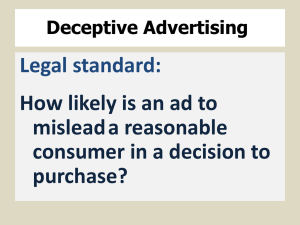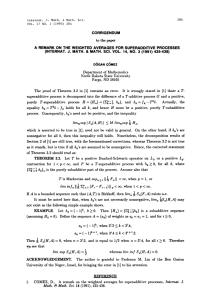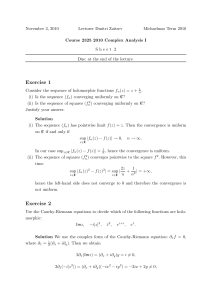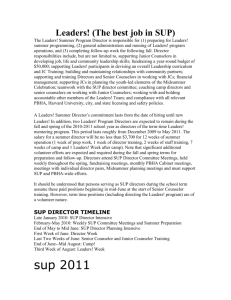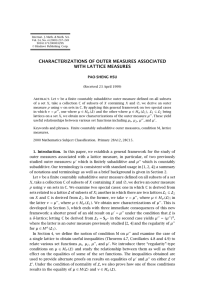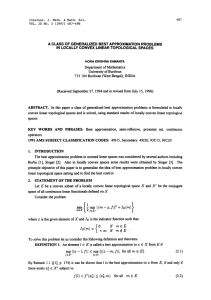Document 10441570
advertisement
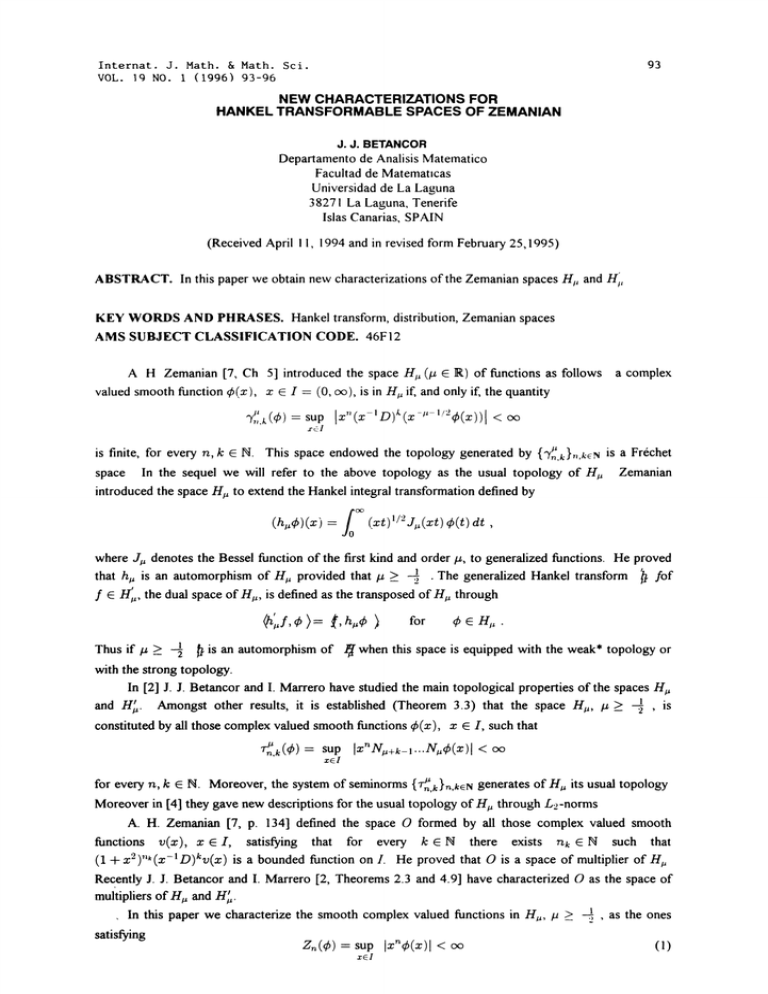
Internat. J. Math. & Math. Sci.
(1996) 93-96
VOL. lq NO.
93
NEW CHARACTERIZATIONS FOR
HANKEL TRANSFORMABLE SPACES OF ZEMANIAN
J. J. BETANCOR
Departamento de Analisis Matematico
Facultad de Matematcas
Universidad de La Laguna
38271 La Laguna, Tenerife
lslas Canarias, SPAIN
(Received April 1, 1994 and in revised form February 25,1995)
ABSTRACT. In this paper we obtain new characterizations of the Zemanian spaces H, and HI,
KEY WORDS AND PHRASES. Hankel transform, distribution, Zemanian spaces
AMS SUBJECT CLASSIFICATION CODE. 46F12
A H Zemanian [7, Ch 5] introduced the space H, (# E IR) of functions as follows a complex
valued smooth function (x), x E I (0, c), is in Hu if, and only if, the quantity
%,.h()
IX (x-’D)(x -’’-
sup
1/2
(z)) <
c
N. This space endowed the topology generated by {7’,},,,kzr is a Fr6chet
space In the sequel we will refer to the above topology as the usual topology of H, Zemanian
introduced the space H# to extend the Hankel integral transformation defined by
is finite, for every n, k
(xt)l/’2J.(zt)(t)dt
(h.)(x)
-
where J# denotes the Bessel function of the first kind and order #, to generalized functions. He proved
The generalized Hankel transform
that h, is an automorphism of H, provided that # >
fof
the dual space of H#, is defined as the transposed of H# through
fE
H’,,
Thus if #
_>
(h’/,f, )= j, h.
is an automorphism of
for
Hr,.
-
when this space is equipped with the weak* topology or
with the strong topology.
In [2] J. J. Betancor and I. Marrero have studied the main topological properties of the spaces H,
is
and H,. Amongst other results, it is established (Theorem 3.3) that the space H,, # _>
constituted by all those complex valued smooth functions (x), z I, such that
Ti:k(
sup Ix"N#+k_...N,(x) < oo
xI
for every n, k 5 N. Moreover, the system of seminorms {’r;,k },,er generates of H, its usual topology
Moreover in [4] they gave new descriptions for the usual topology of H, through L2-norms
A. H. Zemanian [7, p. 134] defined the space O formed by all those complex valued smooth
functions v(x), x I, satisfying that for every k E N there exists nk E N such that
(1 + x2)’"(x-D)kv(x) is a bounded function on I. He proved that O is a space of multiplier of
Recently J. J. Betancor and I. Marrero [2, Theorems 2.3 and 4.9] have characterized O as the space of
multipliers of H, and H,.
as the ones
In this paper we characterize the smooth complex valued functions in H,, p _>
satisfying
Z,()
sup
xeI
94
J. BETANCOR
and
sup INu+r,_l...Nuq(z)[ < oo
(q)
(2)
for every n E N. Moreover we prove that the usual topology of Hu can be defined by the family of
seminorms { Zn, /u },N and a new characterization for the elements of H, is obtained. In the sequel we
will assume that/ >
IROISITION 1. A complex valued smooth function 4(z), z E I, is in Hu if, and only if, q
satisfies (1) and (2) for every n 11.
PROOF. It is clear that if 4 Hu then q satisfies (1) and (2) for every n N.
Let now 4 be a complex valued smooth function defined on I. To see that (1) and (2) (n N) are
sufficient conditions for b belongs to Hu we proceed by induction. Suppose, as induction hypothesis,
that
.
sup IxNu+,_a...Nu(x)l < oo,
x_I
for certain g 11, e > 1.
By using partial integration we can obtain
IlxmNu+e_a...Nu(z)ll
m
_
N
]xmNu+t_l...Nu(x)l
and
11, 0 _< n <
n
dx
x2mN.+t_l...N.(qh(x))N.+t_l...N.(-(x)) dx
(Dx-1)t(x2"+"+t+l/2N,+t_l...N,((x)))x-u-1/2(z) dx
for every m
11,
e < 2m + 2, because
=0
1..
for each i, m
leads to
(D
-
(3)
11, 0 _< < e < 2m + 2. In effect, if m, E 11, 0 < < < 2m + 2 then Leibniz’s rule
) (/"// / N,/t_...N, (())) (- D) t-’- (-"- / ())
az+t+"+--( -zg)t+’-(z-"-v(z))(z -D)
j=0
,. /, _ . N,( ) N,/_ . N,( ) -
--
j=0
where aj, j
follows.
11, 0
j
i, e suitle
r
numbers, d by
ue
of induion
hoesis (3)
Most strghtfod mpulations low us to te
(D -) l (2m++/+1/2 +-I...N,(()))-"-/()
-()N+__I...N,()
Hence we c establish
C2
sup
[(1 +z2)z2m-(z)]
sup [Nu+2t_j_l...Nu(z)l <
,
(4)
NEW CHARACTERIZATIONS FOR HANKEL TRANSFORMABLE SPACES OF ZEMANIAN
95
1, 2, denotes suitable positive constants.
provided that m E N, 2m >_ e. Here C,,
Assume now that m E N, 2m < ?. We have
+
IlxmN,+t-1...N,(x)ll;
i:, N,+t-1 .N,(x) dx
I._l...e( I"
I+_....(m)l a +
Therefore, by invoking (4) and the induction hypothesis we infer that
I1.+_...()11 <
,
when
Thus it is concluded that IlxmN.+_l...N.()ll <
Nso, for eve m N, m 2 1, and x I,
(mN.+_I...N.())
D(tmN.+_...N.e(t))
N, m
m
e N, 2m N e.
e N.
at
+ tm-N.+-...N.((t)) +
2tN.+_...N.((t))([m +. +
Hence if m
,
m
I by using Holder’s inequNity we c find
1, d
IxmNu+t-1...Nu(x)l 2
C
0 such that
(llxNu+e-a...Nu(x)ll
+ sup IN+,...N(x)I [llxN+t-a...N(x)ll2 +
xl
d then sup IxNu+t_...Nu(x)l <
,
m
.
/
Thus the proof is fish.
The lt proposition lows us to define the usu topolo of Hu tough a fly of nos
simpler th {. },kePROSON
The usu tolo of Hu is defin by the system of nos
.
{z,,},.
PROOF. It is cl that the topolo generat by {,k}m.ke is finer th the one de by
{Z,, },e on H. Morver by proing in a way si to A. H. Zem [7, a 5.2-2] we
prove that Hu endow th the topolo generat by { Z,, },e is a Frhet spa. Hen
desk result is iate eonuen ofthe Open Mapping Threm [6, Coroll 2.12].
We now prove a new ehaetion for the clients of the du spa of Hu. The prure
employ is ogous the one u by e author d by J. J. Betcor d I. ero [2].
PROPOS 3. Let f be a lin nio de on Hu. Then f is in
if, d oy
there est r N d f, gk e L(0,) (the spa of essemily bound nctions on (0, )),
keN, 0kr, suchthm
H
H
y
h(zy + z-"+/(z-D)z+"-/O).
,
(5)
k=0
PROOF. t
C > 0 inch that
f
H.
By e of a well-o result ([7, Theorem 1.8-1]) there est r
c
m
0<k<r
{Z(),()}
Hu
(6)
Arding to [7, a 5.4-1(2), (3) d eorem 5.4-1] d since z/2Ju(z is a bounded netion on
I for eve k N one has
J.J. BETANCOR
96
sup
xc:
[xk(x)]
sup
[zkh,,(h,)(x)l < C
IN,+-l...N,(h,)(t)ldt
(7)
and
sup IN,+_...N,(x)I- sup IN,+_,...N,h,(h,)(x)l
xEI
xEl
<C
It(h,)(t)l dt
(8)
for a suitable C > 0.
The linear mapping
is one to one because h, is an automorphism of H ([7, Theorem 5.4-1]). Here LI(0, oo) denotes the
usual Lebesgue space of order 1.
On the other hand, the inequalities (6), (7) and (8) imply that the linear mapping
L"
JH. C L(O, oo) 2‘+2
(xk hu, N.+k_l...N.ht)rk:O
-
C
f qb)
,
+.
is continuous when JH, is endowed with the topology induced by L (0, 00)
Hence, by invoking
th,e Hahn-Banach Theorem L can be extended to L (0, oo) 2+2 as a member of (L (0, 00)2+2) the dual
space of L(0,00) 2+. Since, as it is well known. L(0,00)’= Lo(0,00) there exist f,
gt, Lo (0, 00), k N, 0 < k < r, such that
((fk,xkh.) + (gk,xk+"+l/2(x-lD)k(X-"-l/2)))
(f, qb)
eH
k=0
Therefore
y
k=0
gk
h’.
+ (-
Thus the proof of necesmy if finished.
Conversely, if f is a linear functional defined on
Lo(O, oo), k N, 0 < k < r, then
I(f,)[ <
C (llflloo
k=0
sup
xI
H, by (5)
1(1 +z2)z’(hMb)(z)l + II#lloo sup
I(1
xI
for certain r E N and f,
+z2)N,+,_,...No(ho)(z)l)
for
H,, where Ilolloo denotes the usual norm in Loo(0, oo). Hence, according to [7, Theorem 5.4-1]
and [2, Theorem 3.3], fis in H,.
REFERENCES
[1]
[2]
[3]
[4]
[5]
[6]
[7]
BETANCOR, J.J., Characterization of Hankel transformable generalized functions, lnternat. J.
Math. & Math. Sci., 14 (2) (1991), 269-274.
BETANCOR, J.J. and MARRERO, I., Some linear topological properties of the Zemanian space
H,,BulI. de la Soc. Roy. des Sci. de Liege, 61 (3-4) (1992), 299-314.
BETANCOR, J.J. and MARRERO, I., Multipliers of Hankel transformable generalized functions,
Comment. Math. Univ. Carolinae, 33 (3)(1992), 389-401.
BETANCOR, J.J. and MARRERO, I., A Hilbert space approach to Hankel transformable
distributions, Applicable Analysis, 52 (1994), 103-124.
CHUNG, J., CHUNG, S-Y. and KIM, D., Une caract6risation de l’espace S de Schwartz, C. R.
Acad. ScL Paris, 316 Serie (1993), 23-25.
RUDIN, W., Functional Analysis (Second Edition), McGraw-Hill, Inc., New York, 1991.
ZEMANIAN, A. H., Generalized Integral Transformations, Dover Publications, Inc., New York,
1987.




